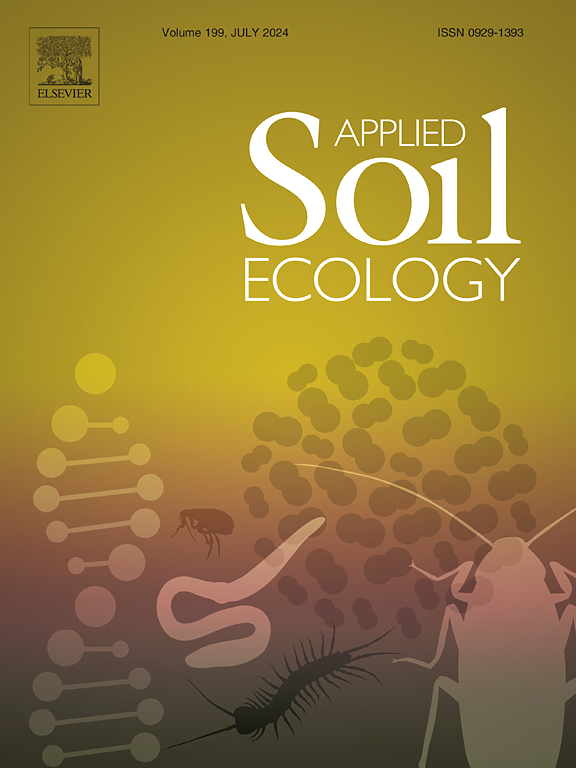Land use change and type of fertilization affect the stability and microbial activity, stoichiometry, and nutrient dynamics in agricultural and forest soils in Avándaro, México
IF 4.8
2区 农林科学
Q1 SOIL SCIENCE
引用次数: 0
Abstract
The conversion from natural ecosystems to intensive agriculture can promote different changes due to constant fertilization. Fertilizations provoke high dependency on nutrient inputs and produce changes in nutrient dynamics, microbial activity, and the composition of soil microbial communities. However, few studies evaluate the high dependency on nutrient inputs with biogeochemical, and enzymatic variables and link the results with nutrient stoichiometry analyses to understand the effect on nutrients availability, microbial activity and biogeochemical cycling. The aim of this work was to analyse the effect of agricultural land use and fertilization with organic and inorganic P on soil nutrient dynamics (C, N and P) in Andosols. We divided the article into three sections, the first one that identifies the effect of land use change on biogeochemical, enzymatic activities, and ecological stoichiometry variables and identifies the dominant processes in each plot to answer: does the sites work as open or closed systems in terms of nutrient exchange and energy? The second section uses the results obtained in section one in order to identify the stability of the biogeochemical variables individually due to the change in land use, calculates resistance and resilience indices, and finally, the third section, covers an incubation experiment on soils from an agricultural site and a pine-oak site, which were fertilized with organic and inorganic compounds with the same concentration of P. At the end of this experiment, the changes in microbial activity and biogeochemical and ecological stoichiometric variables, such as threshold element ratio (TER) were identified, contributing with our data to increase the knowledge about the effects of the changes in soil elemental stoichiometry associated to fertilization, on resistance and resilience of soil organic matter transformation, soil nutrients availability and enzymes synthesis. With the variables analysed in these sections we aim to answer the following questions: will organic agriculture modify the stability of soil nutrient transformation, organic nutrient stores and activity of enzymes that degrade organic matter? and, what effects will fertilization have on the enzymatic activities linked to phosphorus? Our results suggest that the availability of PO43− and NO3− are the variables that explain most of the variance that affects the nutrient dynamics in the agricultural plot, concluding that this site depends on nutrient inputs and acts as an open system. We identified that most of the variables are highly resistant; however, the nitrification process shows high vulnerability (less resistance, lower than 0.5) and is affected by the change in land use. In the final section, we found that both types of fertilization (inorganic and organic) negatively affected the activity of the β-glucosidase (BG) enzyme (0.068 μmolPNP g−1 h−1 for the control versus 0.010 and 0.007 μmolPNP g−1 h−1 for each fertilization respectively in the agricultural site). We identified N limitation induced by organic fertilization (LogeDOC:DON = 3.61 ± 0.4, LogeTERC:N = 0.6 ± 0.85; p = 0.02) and C limitation due to inorganic fertilization (LogeDOC:DOP = 2.66 ± 0.5, LogeTERC:P = 3.7 ± 1.3; p = 0.02). In conclusion, our results showed that the change in land use and organic and inorganic fertilizations with P modify processes related not only to P but also to C and N dynamics with changes in microbial activity. This study shows how land use change modify soil nutrients and energy flows in the ecosystem, quantified the vulnerability of soil microbial processes and provides information about the relevance of knowing the nutrient stoichiometry of fertilizer before to be applied.
土地利用变化和施肥类型影响墨西哥阿万达罗农业土壤和森林土壤的稳定性、微生物活动、化学计量学和养分动态
从自然生态系统到集约农业的转变会因持续施肥而产生不同的变化。施肥引起对养分输入的高度依赖,并导致养分动态、微生物活动和土壤微生物群落组成发生变化。然而,很少有研究通过生物地球化学和酶变量来评估对养分输入的高度依赖性,并将结果与养分化学计量分析联系起来,以了解对养分可用性、微生物活动和生物地球化学循环的影响。这项工作的目的是分析农业用地以及有机和无机钾肥对 Andosols 土壤养分动态(碳、氮和磷)的影响。我们将文章分为三个部分,第一部分确定了土地利用变化对生物地球化学、酶活性和生态化学计量变量的影响,并确定了每个地块的主导过程,以回答:就养分交换和能量而言,这些地点是作为开放系统还是封闭系统运作?第二部分利用第一部分获得的结果,确定土地用途变化导致的生物地球化学变量各自的稳定性,计算抵抗力和复原力指数,最后是第三部分,包括对农业用地和松树-栎树用地的土壤进行培养实验,这两块土壤分别施用了有机和无机化合物,磷的浓度相同。实验结束时,确定了微生物活动以及生物地球化学和生态平衡变量(如阈值元素比(TER))的变化,这些数据有助于进一步了解与施肥相关的土壤元素平衡变化对土壤有机质转化、土壤养分供应和酶合成的抵抗力和恢复力的影响。通过这些章节分析的变量,我们旨在回答以下问题:有机农业是否会改变土壤养分转化的稳定性、有机养分储存量和降解有机物的酶的活性? 施肥对与磷有关的酶的活性有什么影响?我们的研究结果表明,PO43- 和 NO3-的可用性是影响农田养分动态的大部分变量的解释因素。我们发现,大多数变量都具有较高的抗性;但是,硝化过程显示出较高的脆弱性(抗性较低,低于 0.5),并受到土地利用变化的影响。在最后一部分,我们发现两种施肥方式(无机肥料和有机肥料)都会对β-葡萄糖苷酶(BG)的活性产生负面影响(对照组为 0.068 μmolPNP g-1 h-1,而农业区每种施肥方式的影响分别为 0.010 和 0.007 μmolPNP g-1 h-1)。我们发现有机肥会导致氮限制(LogeDOC:DON = 3.61 ± 0.4, LogeTERC:N = 0.6 ± 0.85; p = 0.02),无机肥会导致碳限制(LogeDOC:DOP = 2.66 ± 0.5, LogeTERC:P = 3.7 ± 1.3; p = 0.02)。总之,我们的研究结果表明,土地利用的变化以及有机和无机磷肥的施用不仅改变了与磷有关的过程,还改变了与碳和氮的动态变化有关的过程,同时也改变了微生物的活动。这项研究显示了土地利用的变化如何改变生态系统中的土壤养分和能量流,量化了土壤微生物过程的脆弱性,并提供了在施肥前了解肥料养分化学计量学相关性的信息。
本文章由计算机程序翻译,如有差异,请以英文原文为准。
求助全文
约1分钟内获得全文
求助全文
来源期刊

Applied Soil Ecology
农林科学-土壤科学
CiteScore
9.70
自引率
4.20%
发文量
363
审稿时长
5.3 months
期刊介绍:
Applied Soil Ecology addresses the role of soil organisms and their interactions in relation to: sustainability and productivity, nutrient cycling and other soil processes, the maintenance of soil functions, the impact of human activities on soil ecosystems and bio(techno)logical control of soil-inhabiting pests, diseases and weeds.
 求助内容:
求助内容: 应助结果提醒方式:
应助结果提醒方式:


